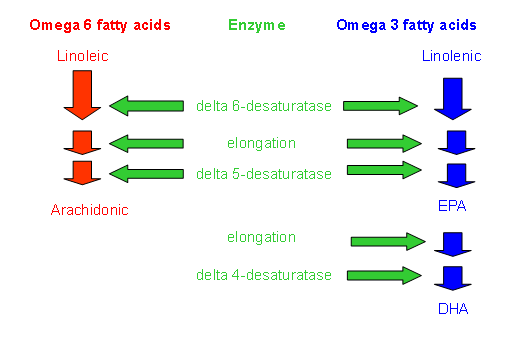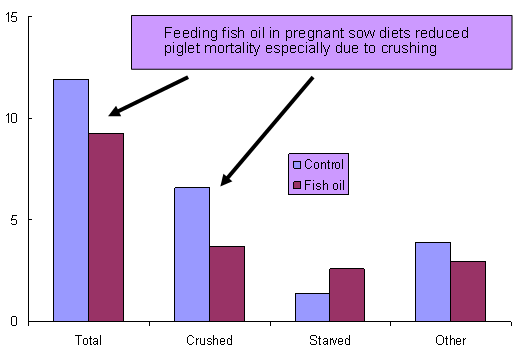Fatty acids
In addition to the general importance of fat as an energy source, essential fatty acids are important in maintaining correct body function. There are two essential fatty acids which must be supplied in the diet: linoleic and linolenic acids. These have 18 carbon atoms and belong to the omega 6 (linoleic) and omega 3 (linolenic) families of fatty acids. However, it is the longer chain fatty acids synthesised from linoleic and linolenic acids that are important biologically. Arachidonic acid is synthesised from linoleic acid and eicosapentaenoic (EPA) and docosahexaenoic (DHA) acids from linolenic acid.

Essential fatty acid requirements
Pig requirements for fatty acids are given for omega-6 fatty acids as linoleic acid but not for omega-3 fatty acids. It is assumed that normal diets provide an adequate supply of omega-3 fatty acids. In human nutrition however requirements are given not only for both omega-3 and omega-6 fatty acids but also specifically for EPA and DHA. Indeed extra DHA is recommended for pregnant mothers. Like the human baby, the piglet requires DHA for brain growth most of which takes place the last third of gestation.
What about pregnant sow diets
The Table below shows that most feed ingredients used in pregnant sow diets contain more omega-6 than omega-3 fatty acids. The fatty acids are present almost entirely as linoleic and linolenic acids. Feeds can have ratios of omega-6 to omega-3 fatty acids that are sometimes greater than 10. As the same enzymes synthesise the long chain fatty acids from both omega 6 and omega 3 fatty acids, the ratio of linoleic acid to linolenic acid determines which long chain acids are produced. Therefore an excess of omega-6 fatty acids will reduce EPA and DHA synthesis. In human diets, a ratio of omega 6 to omega 3 of less than 8 is recommended. So pregnant sow diets may first, have too high an omega-6 / omega-3 ratio and secondly, be lacking in EPA and DHA.
Essential fatty acids in common feeds (% total fatty acids)
| Wheat | Maize | Soya | Sugar beet pulp | |
| Omega 6 | 56.3 | 50.5 | 52 | 25 |
| Omega 3 | 3.7 | <3 | 7 | 4 |
| Ratio | 15 | 17 | 7 | 6 |
What feeds can supply omega-3 fatty acids
The best sources of EPA and DHA are fish oils but these are expensive and there are concerns about the sustainability of fish oil production. The most important vegetable source of omega-3 fatty acids (as linolenic acid) is linseed either as full fat linseed or linseed oil. The disadvantage of linseed is that there are doubts as to how efficient synthesis of DHA from linolenic acid is.
Do omega-3 supplements work?
Litter size and mortality
Over all studies using fish oil supplements, the number of pigs born alive (0.2 to 0.7 pigs / litter) and weaned (0.3 to 1.3 pigs / litter) improved when sows were provided diets that contained omega-3 fatty acids supplements. Feeding linseed may also increase litter size. An increased litter size at weaning may arise from a reduction in piglet mortality. In one study where causes of pre-weaning mortality were investigated, feeding fish oil did indeed reduce mortality especially that cause by crushing by the sow (see Fig.). Are there any adverse effects of n-3 fatty acids? Recent studies where pigs have been followed through to slaughter weight, have shown no adverse effects of different types of fatty acid have been observed.
Post-weaning performance





